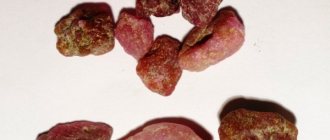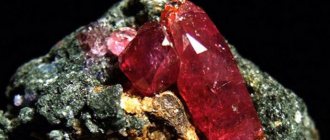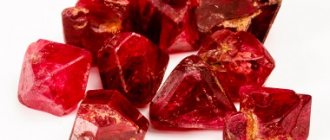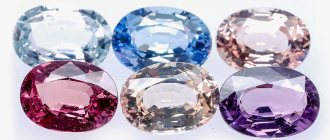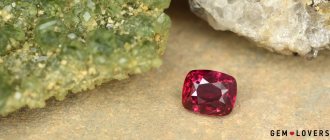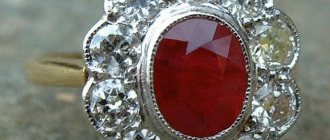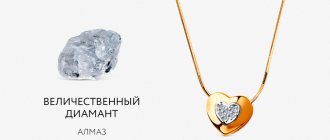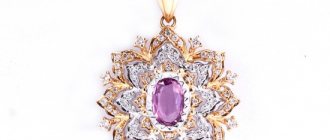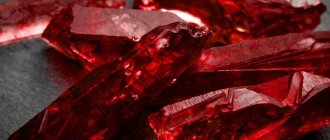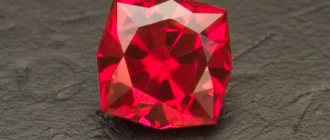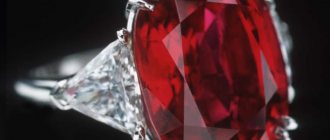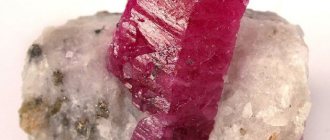Ruby is a transparent gemstone with a bright red color. It is a variety of the mineral corundum. Its name comes from the Latin “rubens” - red. A high-quality ruby with rich color is extremely rare and often has a very high price.
The red color of ruby is due to traces of chromium. Its color can vary from blood red to orange-red, purple and even pinkish red. Chromium replaces aluminum in the mineral and changes its hue. It has a hardness of 9 on the Mohs scale and is only behind diamond, which scores a 10.
Rough Ruby
Today, ruby is one of the most popular and expensive gemstones on the mineral market. For centuries, members of the nobility and high clergy adorned themselves with rubies; it was a desirable stone for many people. I suggest you take a closer look at this beautiful stone and find out why it is so attractive and how it differs from other minerals.
Ruby color
The best color for a ruby is considered to be a deep, bright red. However, its colors can vary in hue, saturation and secondary colors, meaning some rubies can have a pink, brown, purple or orange tint.
Hue is the main indicator of the color of a ruby. Although absolute red is the ideal color, many Myanmar specimens have a slightly purple tint. As the hue of a mineral becomes more purple or orange, its quality deteriorates and it loses its value.
Tone describes how light or dark a ruby's color is. The stone should not be too dark so that its color is obscured. Or too light that it appears washed out and unclear. Some Thai specimens are garnet red in color due to their dark tone. On the other hand, if the tone is too light, the stone can be considered a pink sapphire. Even if its saturation is high.
ruby light tone and orange hue
Talismans and amulets
The stone is an excellent amulet for military personnel and firefighters, protecting them from death. It warns owners of danger by changing its color.
It is believed that the ruby talisman will protect against natural disasters and negative magical effects. If you have a ruby crystal in your house, it will protect your home from fire and thieves.
If you wear a stone amulet constantly, then good luck will always accompany its owner . Any situation, be it finances, health or work, will change for the better.
The energy of the stone allows a person to strive for everything new and unknown, opening up vast horizons of possibilities. Such a talisman will help people of mental and creative professions, as well as those who love adventure.
A gem amulet can bring prophetic dreams. If a person dreams of a ruby, then luck, success and prosperity await him in life.
Varieties of rubies
Rubies come from all over the world and are available in a variety of shades. However, they are divided into specific types depending on the country or region in which they are mined. Common types include:
- Burmese rubies. Stones from Burma, now Myanmar, are generally considered to be among the most coveted in the world. They have a dark red color that stands out and can look special.
- Thai rubies. Thai has a deeper, but less saturated color than Burmese, and is considered second in quality. They typically contain higher levels of chromium and iron, which contribute to their unique hue.
- African rubies. Corundums from African countries such as Kenya and Mozambique are dark red or red-violet. Dark red African ones are popular due to their rich color.
- Pigeon's blood rubies. Corundums of the “pigeon’s blood” shade are especially desirable and valuable. They are bright red in color with a soft purple tint. In the light they appear dark red.
Pigeon's blood ruby
Magic properties
First of all, ruby is a stone of power.
It raises the political authority of its owner and contributes to the growth of his political career. Also, the gem is a symbol of love.
It helps people who own it to learn love, compassion, self-sacrifice, selflessness both towards individuals and towards humanity as a whole, thereby bringing harmony and joy to the world.
The stone symbolizes passionate love. It is presented as a gift to those people from whom they want to achieve reciprocity.
It is believed that the stone changes color as danger approaches. Ruby has great mystical significance.
It is an excellent amulet against damage and the evil eye, and also protects against the machinations of ill-wishers. The unprocessed gem was worn by those who were afraid of being poisoned.
The mineral enhances those human qualities that predominate in it. He makes the good one better, and the evil one more evil. A stone can bring misfortune to someone whose character traits are far from perfect. Rubin prefers those people who have purity of thoughts and strength of character, and he also does not tolerate lies.
The magical power of the gem is used by people with superpowers - magicians, sorcerers and psychics.
Size
The size of a gemstone, expressed in unit weight, is called a carat (abbreviated “ct”). A carat is a metric unit equal to one-fifth (0.20) of a gram. A one carat ruby will appear smaller than a diamond due to its high specific gravity.
It is worth noting that usually the size of a ruby does not exceed 1 carat. This is because chromium, which causes its red color, is relatively rare in corundum.
Oval cut ruby 1 carat $1500
Ruby forms in the earth's crust in the form of octahedral crystals, that is, wide and flat plates. This makes large rubies difficult to cut and makes stones larger than a carat exceptionally rare.
While a five-carat size is considered small for an aquamarine, a quality five-carat ruby is large enough to attract the attention of serious collectors. High quality stones of more than one carat are rare and very expensive. The most valuable ruby is intense, bright red, large in size (over 5 carats), fairly clean and perfectly cut.
2 carat pigeon blood ruby $15,000
What stones does it go with?
Combination with amethyst
Combination with pearls
Combination with turquoise
Ruby goes well with gems such as agate, amethyst, white pearl, beryl, turquoise, emerald, coral, lapis lazuli, sapphire, carnelian.
Absolutely incompatible with malachite, onyx, obsidian, sardonyx.
It has inconsistent compatibility with aquamarine, garnet, rose quartz, heliotrope, moonstone, opal, jasper, and neutral compatibility with topaz.
Clarity
Clarity refers to the number, size, color and quality of defects in a mineral, which are known as inclusions. Rubies can be clear and pure (with inclusions that are hard to find even with magnification), but they are very few in number. Clarity affects the price of rubies depending on the type, location, number and size of inclusions.
Gemologists use 10x magnification to measure the clarity of a diamond. However, magnification is not used with colored gemstones. They are assessed by the so-called “cleanliness of the eye.” That is, they study how clean the stone is and does not contain inclusions when viewed with the naked eye. The better the transparency, the more expensive the ruby.
Silk inclusions of rutile in the mineral under magnification
All natural rubies contain some inclusions, also known as rutile needles or "silk". If a mineral does not have visible rutile needles, a gemologist will suspect that it is processed or synthetic.
Inclusions are a natural consequence of crystal growth. Ruby inclusions vary depending on its origin and its processing history. Each inclusion will contribute differently to shine, color and vibrancy.
Small color zoning
Medicinal properties
The healing properties of the stone have been known since ancient times.
Lithotherapists use it to treat:
- digestive organs;
- joints and spine;
- throat diseases;
- paralysis and epilepsy;
- blood diseases;
- hypertension.
Also, the mineral improves immunity, relieves insomnia and depression, and improves metabolism.
If you place a gem in water and let it sit for a day, then this water helps rejuvenate the skin, restoring damaged cells, alleviates the human condition from colds, improves metabolism and removes toxins.
The stone is considered feminine, as it relieves the fair sex from gynecological ailments and helps them get pregnant.
Types of inclusions
- Cavities. These are voids or holes that extend from the surface of the mineral into the interior.
- Color zoning. This term refers to areas or bands of variable color in a mineral. Color zoning occurs naturally during crystal formation. It is most noticeable in untreated stones.
- Crystals containing minerals. Ruby often contains tiny crystals of pyrite, garnet, zircon, calcite and spinel.
- Liquid inclusions. These are fluid-filled spaces inside the stone. In naturally formed corundum, the presence of carbon dioxide in the form of liquid inclusions is a sign that no heat treatment was used.
- Silk. The term refers to fine needles of rutile. In small quantities, highly reflective rutile needles cause light to scatter within the cut ruby. This process will then lighten the darker facets of the mineral and enhance its shine.
Mineral crystals in ruby
Silk is a type of inclusion that can add value to the stone. Silk is also responsible for the asterism of star rubies. In this case, with the right lighting, three- or six-pointed stars are visible on the sample. This occurs when light reflects off rutile needles, creating a star effect.
When a ruby with abundant silk is cut as a cabochon, the reflections from the rutile needles form a six-pointed star. In rare cases, star rubies can have twelve points. This effect is obtained due to the presence of hematite needles. Because the star's appearance depends on inclusions of silk, star corundums never achieve the degree of purity that is possible in faceted stones.
Dark red ruby cabochon with a perfect six-pointed star
Durability
The strength of a stone is assessed according to three parameters:
- Hardness
- Strength
- Stability
Ruby is difficult to scratch and ranks 9 on the Mohs scale (hardness 1 to 10) as a type of corundum. Diamonds are the only natural stone harder than corundum.
Toughness refers to a mineral's susceptibility to chipping and cracking. Corundum has no cleavage planes, although it tends to cleave. This means that rubies are very durable and resistant to breaking and cracking.
Stability refers to how much a mineral is affected by things like light, temperature changes, and chemicals. Rubies react little to light, temperature changes and various chemicals. This makes ruby jewelry ideal for frequent use, such as rings and bracelets.
Interesting Facts
The high hardness of the mineral allows it to make deep scratches on glass. However, if you want to check the authenticity of your stone, do not try to test its strength in this way.
If the ruby turns out to be real, then there is a high probability that the stone will begin to crumble under pressure.
If you like the gem, the price suits you, and the jewelry store inspires trust, then think again and... buy it! And if you find it difficult to choose a pebble, contact the seller, he will be happy to help you!
Field
Most rubies come from two sources: Myanmar, better known as Burma, and Mozambique. Burmese rubies are considered the standard, as Myanmar is historically the main producer.
Other sources can also produce stones of excellent color and quality, although some have regional characteristics. Rubies are also mined in Thailand, Sri Lanka, Tajikistan, Brazil, Madagascar and some other countries.
Care
Care involves proper storage and cleaning of the stone from dirt. Store ruby separately from other gems:
- It is best to purchase an individual box for him and place it in the eastern part of the home.
- Once a week, the stone must be cleansed of negativity using running water, under which the gem is placed for several hours.
- Also, it needs to be cleaned of dirt from time to time using a soap solution and a soft cloth.
